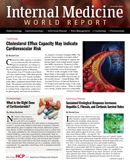Publication
Article
Delayed Antibiotic Prescribing for RTIs Lowers Antibiotic Use
Author(s):
Strategies of no antibiotic prescription or delayed antibiotic prescription in primary care patients with acute respiratory tract infections (RTIs) resulted in fewer than 40% of patients using antibiotics, according to a study published in BMJ.

Strategies of no antibiotic prescription or delayed antibiotic prescription in primary care patients with acute respiratory tract infections (RTIs) resulted in fewer than 40% of patients using antibiotics, according to a study published in BMJ.
Researchers used an open, pragmatic, parallel group, factorial, randomized controlled trial in a primary care setting in the United Kingdom (UK) in 889 patients aged 3 and older.
Previous analyses had concluded that a strategy of either no antibiotic prescriptions or a delayed antibiotic prescription was effective for uncomplicated RTIs and reduced antibiotic use. However, concerns had been presented that delayed prescriptions resulted in poor symptom control and that no antibiotic prescription could lead to increased need for reconsultations.
In the study, the patients who did not require immediate antibiotics were randomized to undergo 4 strategies of delayed prescription: recontact for a prescription, postdated prescription, collection of the prescription, and receipt of the prescription (patient led). During the trial, a strategy of no antibiotic prescription was added as another randomized comparison. The primary analysis was intention to treat.
The key outcomes measures were main symptom severity (0 to 6 scale) at days 2 through 4, antibiotic use, and patients’ belief in the efficacy of antibiotic use.
Mean symptom severity held minimal differences between the strategies involving no prescription and delayed prescription (recontact, postdate, collection, patient-led, 1.62, 1.60, 1.82, 1.68, 1.75, respectively; likelihood ratio test χ2, 2.61; P = 0.625). Duration of symptoms rated moderately bad or worse also did not differ between no prescription and delayed prescription strategies combined (median 3 days vs 4 days; 4.29, P = 0.368). There were modest and nonsignificant differences in patients very satisfied with the consultation between the randomized groups, belief in antibiotics, or antibiotic use. In contrast, most patients given immediate antibiotics used antibiotics (97%) and strongly believed in them (93%) but with no benefit for symptom severity (score 1.76) or duration (median 4 days).
The authors concluded that strategies of no prescription or delayed antibiotic prescription resulted in fewer than 40% of patients using antibiotics. Although they were associated with weaker beliefs in antibiotics, the results exhibited similar symptomatic outcomes to immediate prescription. They noted that if clear advice is given to patients, “there is probably little to choose between the different strategies of delayed prescription.”






